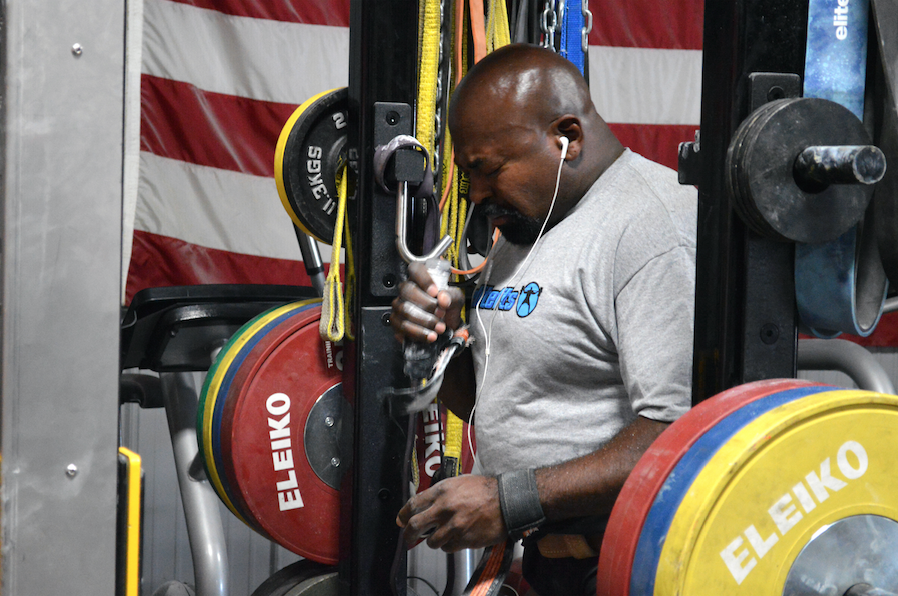
A champion boxer dances into the ring while his chosen walkout music plays. A powerlifter trains in a quiet basement gym. A bodybuilder trains in a gym blasting hip-hop through the speakers. Michael Phelps inserts waterproof headphones in his ears and begins his warm-up laps. A marathon runner chooses the perfect playlist for today’s 10-mile run.
All of these athletes utilize music in their training or competition. This raises the question: Can music create a real, physiological advantage for athletes? If so, what are the underlying mechanisms of action? Furthermore, how can an athlete manipulate the music they listen to for a specific goal?
Using relevant scientific literature as a background and examining case-by-case examples of sports that clearly demonstrate music-intervention pathways, this question can systematically be addressed. Let’s take a look at multiple athletic disciplines and examine their unique uses of music.
Music as a Motivator
Music as a motivator is quite a simple concept. Music has the ability to increase or lower heart rate, blood pressure, and respiration rate in accordance with tempo. (Roth, 2013) Along with an increase in these rates, one may feel more alert and ready for action. A simple example of this psychophysiological effect on mood is a study performed in 2005, revealing that workers who listen to music were more productive than those who didn’t. (Lesuik, 2005) Another study proved that music can serve as a kind of stimulant (or sedative) due to changes in emotional and physiological arousal. (Bishop, D. T., Karageorghis, C. I., & Loizou, G., 2007)
MORE: The Team elitefts Original Soundtrack
Music in Training and Competition
Music and athletic training seem to go hand-in-hand since the beginning of the fitness industry. Music has always accompanied physical exercise in home-fitness videos such as P-90x and Insanity, and it is no coincidence. It has been found that there are five different pathways in which music provides aid in training and performance: dissociation, arousal regulation, synchronization, acquisition of motor skills, and attainment of flow. (Karageorghis, C., & Priest, D., 2008)
Bodybuilding
As you know, bodybuilding style training involves lifting medium to heavy weights in an isolation style movement for high repetitions. Music has a clear-cut ability to shine and improve an athlete’s training experience in this instance. Firstly comes motivation, a topic previously discussed. Heart rate, respiration and blood pressure all increase with an increase in tempo as someone listening to music actively chooses music s/he enjoys. Arousal regulation is thusly positively impacted to stimulate a positive mental training environment. This environment, in turn, positively affects the trainee’s “attainment of flow.” A bodybuilder actively listening to enjoyable music will get into a groove faster, feel better, and will be more excited to train. Karageorghis and Deeth (2002) found that athletes scored higher on a Flow State Scale during a multi-stage fitness test due to the positive emotional impact of enjoyable music.
In terms of bodybuilding competition, music is channeled through a much different pathway. Music during competition takes the form of posing music, and the pathway it takes to improve performance is the acquisition of motor skills. Bodybuilders will select music that makes them feel confident about their physiques and will aid in their posing. Selected music will contain certain beats, tones, and signals that will prompt the bodybuilder to hit certain poses at the correct time — a timing predetermined by the bodybuilder and coach as containing the best possible movement to showcase the physique. Bodybuilders will practice moving with their selected movement so as to showcase smooth transitions from different poses in accordance with their music.
Additionally, from the perspective of the judge or audience, music's role is incredibly powerful. Imagine viewing someone hitting a front double bicep pose to "Never Gonna Give You Up" by Rick Astley. Not so powerful, right? Now imagine that same front double bicep pose hit right as Brian Johnson of AC/DC belts out "you've been..THUNDERSTRUCK!"
The sound that blares from the speakers resonates in your ears. Your amygdala (the brain's fight or flight center) activates and your eyes involuntarily analyze the environment around you to figure out where such power, such danger might be coming from. Those flexing biceps are being displayed at full capacity and due to this sympathetic appeal to your nervous system, your brain is being hacked. Your heart rate increases and your body consumes more oxygen. You may not be sure why, but the biceps flexed to Thunderstruck impress you more.
High Intensity Cardio and Power: Crossfit, Boxing, Etc.
High intensity cardio and power performance seems to be where the use of music flourishes in its impact. In these athletic environments, training is obtained through raw competition, and competition can be viewed as training. Therefore, we will group training and competition together for these sports.
In 1997, Karageorghis & Terry said that in competitions in which the abilities of athletes are similar, music has a small but significant effect on performance. So how exactly does music produce an effect?
First, an obvious contributor is arousal regulation. Crossfit athletes routinely listen to loud, furious music to psych themselves up for intense weightlifting and cardio that they know will be challenging. This “psyching up” creates a positive mood and environment that contributes to an athlete’s own confidence for performing complex movements. In boxing, competitors get to pick what music they will walk into the ring to. This “walk-out music” is something hand chosen by the competitors to psych the competitor up and again provide confidence going into a fight.
RELATED: 20 New Songs Added to Team Elitefts Spotify Playlist
However, in both sports, it would not be fair to say that loud, aggressive music is the only music with a positive impact. A smaller but still significant number of competitors actually prefer to listen to music that calms them down, as too much hype and over-stimulation of their sympathetic nervous system might hurt performance by making them jittery or unconfident. More on this subject in a bit.
The second contributor to music's positive effects is dissociation. Music has the ability to distract athletes during sub-maximal exercise and reduce feelings of discomfort and fatigue, and lowers the athletes own perception of effort. Positive moods flourish and negative moods dissipate. (Bishop et. al., 2007) Music allows athletes to keep pushing hard until the job is finished. In Crossfit this is readily observed: Crossfit boxes (gyms) will often select certain playlists and music for types of workouts with the idea being that some athletes will be able to find motivation to continue when the going gets tough. However, it should be noted that music has limitations in dissociation. Athletes competing/training to a maximum of their abilities do not get the same analgesic-like effects of music due to the body’s own dominance in physiological functioning over attention to outside factors. Music, however, can make such maximal exercise more enjoyable.
The third contributor is synchronization. Playing music with a tempo that matches the pace of an activity will actually increase the ability of an athlete to do that movement more efficiently. One study found that athletes who cycled along with music that contained a tempo that matched their pace required 7% less oxygen than athletes who cycled to music that did not match movement tempo. (Bacon, C., Myers, T., & Karageorghis, C. I., 2008). In Crossfit, this can be observed in activities like rowing or anything that involves quick movements for many reps, such as box jumps.
The fourth contributor is the ability of music to provide for an easier attainment of flow. Again, this positive competition/training environment will make it easier for an athlete to find his/her best feeling zone to perform in. A solid flow state contributes to positivity and confidence within an athlete and allows them to perform the best of their ability.
Powerlifting
The use of music in powerlifting training demonstrates quite a different story altogether. While some powerlifters will listen to loud, angry music that stimulates their aggression and awareness, utilizing the arousal regulation pathway, a growing number of powerlifters actually prefer to train in silence or even with music they detest. For powerlifters, their goals are all tested in competition, and training in silence (or in detestable, distracting music) maintains a damage control mechanism for competition time. If a powerlifter were to only train in loud, enjoyable music that employed arousal regulation, that same powerlifter might falter on the platform if the competition director did not play his/her preferred style of music. For a powerlifter, knowing that they can perform maximal lifts in silence (or non-motivational, distracting music) provides confidence for competition performance.
When it comes to competing in powerlifting, music will again take on a positive role. Arousal regulation takes on the primary pathway; powerlifters get in the zone by listening to music they enjoy and music that sets the tone for how they will perform on the platform. Powerlifters often pick performance songs that can be listened to with personal devices immediately before they take the platform. Powerlifters will also develop “anchors”—emotions tied to certain thoughts, events, or actions—that when combined with music and other hype-up factors will result in very powerful emotional states that can induce maximum physiological strength abilities. Cain Morano talks about anchoring in his article Visualizing a Lift, Part 2: Ritual Reinforcement.
In my own personal experience I have found that combining thoughts of troubling childhood events, huffing ammonia, and listening to my chosen anchor song (Phoenix Flame by The Ghost Inside) helps me reach maximal performance. However, keep in mind, not all anchor music has to be extreme. Sometimes the music you would never expect can have extreme physiological effects in some people. A former elitefts intern is a fantastic example of this; his anchoring rituals are quiet and deliberately slow: Careful hand chalking, light-footed walking, slow movements. He will even sit motionless in the dark before max effort attempts. Come time for his attempt, he releases his energy to Andrea Bocelli's Por Ti Volare.
Endurance Sports — Running, Swimming, Etc.
In endurance-style sports such as running, swimming, and cycling, the effect of music can be so profound that sport federations will go to great lengths to ban music for the sake of preventing competitors from having an unfair advantage. U.S.A. Track & Field banned personal music devices in 2007, as runners would use the music to gain an advantage over those who competed without music. (Macur, 2007) The effect of music on a sport such as running is obvious from what we’ve previously discussed. Arousal regulation occurs before the race from listening to positive, motivating music. Dissociation can occur during the race from focusing less on the act of running and more on the music one is enjoying. Acquisition of motor skills could be obtained from listening to music that encourages stepping, running, or sprinting to one’s goals. Attaining a flow state would also allow the athlete to get into a competitive, driven mindset and music would encourage such a flow state. Finally, the largest musically driven effect would be synchronization. Synchronization, again, is the pathway that has been proven to have a real, measurable effect on exertion. Running in step with music would set a pace for the athlete and encourage efficiency- the athlete would need less oxygen than competitors running without music.
Music in Recovery
While music has proven benefits in application during sport activities, its benefits don’t stop at the finish line. Music has also been proven to help with post-exercise recovery. A study in 2008 found that athletes listening to relaxing music for 15 minutes post sub-maximal exercise decreased heart rate, urinary protein, and rate of perceived exertion significantly compared to athletes who did not listen to music afterwards. (Jing, L., & Xudong, W. 2008)
Inspiration and Motivation: 6 Articles to Help You Find Your Inner Drive
So What Does This Mean For You?
Music has a concrete, observable effect on athletic training and competition. We have examined a broad spectrum of sports and the impact music has on an athlete’s ability to perform to their best ability in those sports. The physiological influences such as heart rate and respiration have been shown. Their impacts are illustrated by various music types, sport types, and goals. It has been determined that there are five main pathways for music to influence athleticism: arousal regulation, dissociation, synchronization, acquisition of motor skills and attainment of flow.
These illustrations can be applied quite easily to athletes in all sport disciplines and even non-athletes alike. If someone is new to fitness and wants to go on a run but fears the pain of running and cardio, all s/he need do is throw some headphones in and prance along to his/her favorite song. If an athlete approaches competition in the wrong mindset, a simple song or two may prepare that athlete to play at his/her best. Bodybuilders can make or break a routine with their music choice, and powerlifters can tap into some extreme focusing abilities with a killer anchor. Music has a profound effect. We should not be surprised that competitions are putting handcuffs on headphones.
References
- Bacon, C., Myers, T., & Karageorghis, C. I. (2008). Effect of movement-music synchrony and tempo on exercise oxygen consumption. Manuscript submitted for publication.
- Bishop, D. T., Karageorghis, C. I., & Loizou, G. (2007). A grounded theory of young tennis players’ use of music to manipulate emotional state. Journal of Sport & Exercise Psychology, 29, 584–607
- Jing, L., & Xudong, W. (2008, March 4). Evaluation on the effects of relaxing music on the recovery from aerobic exercise-induced fatigue. Retrieved April 17, 2015, from http://www.ncbi.nlm.nih.gov/pubmed/18212717
- Karageorghis, C. I., & Deeth, I. P. (2002). Effects of motivational and oudeterous asynchronous music on perceptions of flow [Abstract]. Journal of Sports Sciences, 20, 66–67.
- Karageorghis, C., & Priest, D. (2008, July 7). Music in Sport and Exercise : An Update on Research and Application | The Sport Journal. Retrieved April 17, 2015, from http://thesportjournal.org/article/music-sport-and-exercise-update-research-and-application/
- Karageorghis, C. I., & Terry, P. C. (1997). The psychophysical effects of music in sport and exercise: A review. Journal of Sport Behavior, 20, 54–68.
- Lesuik, T. (2005, April 1). The effect of music listening on work performance. Retrieved April 17, 2015, from http://pom.sagepub.com/content/33/2/173
- Macur, J. (2007, November 1). A marathon without music? Runners with headphones balk at policy. Retrieved April 17, 2015, from http://www.nytimes.com/2007/11/01/sports/01ihtrun.1.8142612.html?pagewanted=all&_r=1&
- Roth, E. (2013, August 19). Relationship Between Music and Heart Rate. Retrieved April 17, 2015, from http://www.livestrong.com/article/75323-relationship-between-music-heart-rate/
Andy Hingsbergen is a student at The Ohio State University, finishing up his Bachelor's in Psychology. Andy competes in powerlifting and is currently setting his sights on taking the physique stage. He is originally from Springboro, Ohio.












